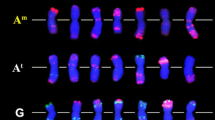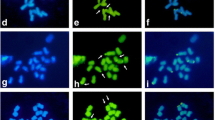Abstract
The Narcissus variety, ‘Tête-à-Tête’, has been the most popular variety since 1949, and a well known allotriploid (2n = 3x = 24 + B) of spontaneous origin. Because the identity of one of the parents of this variety was uncertain, the genome constitution of ‘Tête-à-Tête’ was investigated by using genomic in situ hybridization (GISH) and NBS profiling. Both of these techniques confirmed that two different species of Narcissus, viz., N. tazetta (2n = 2x = 20) and N. cyclamineus (2n = 2x = 14) are the parents. GISH clearly identified 10 chromosomes of N. tazetta and 14 chromosomes of N. cyclamineus, the former has contributed one and the latter has contributed two genomes. One B chromosome was identically labelled as those of N. cyclamineus indicating the affinity of the special chromosome to this species. Due to its male and female sterility ‘Tête-à-Tête’ is unsuitable as a parent for utilizing in further breeding, it might be possible to re-synthesize a ‘Tête-à-Tête’ like variety using the now known parents and the original pathway.


Similar content being viewed by others
References
Barba-Gonzalez R (2005) The use of 2n gametes for introgression breeding in oriental × asiatic lilies. Dissertation, 107pp, Wageningen University
Brandham PE (1986) Evolution of polyploidy in cultivated Narcissus subgenus Narcissus. Genetica 68:161–167
Brandham PE, Kirton PR (1987) The chromosomes of species, hybrids and cultivars of Narcissus L. (Amaryllidaceae). Kew bulletin 42:65–102
Brandham PE, Fraser E, West J (1995) DNA amount, polyploidy and selection of cultivars of decorative monocotyledons. In: Brandham PE, Bennett MD (eds), Kew chromosome conference IV. Royal Botanic Gardens, Kew, pp 37–46
Calenge F, Van der Linden CG, Van de Weg E, Schouten HJ, Van Arkel G, Denance C, Durel CE (2005) Resistance gene analogues identiWed through the NBS-proWling method map close to major genes and QTL for disease resistance in apple. Theor Appl Genet 110:660–668
Diaz Lifante Z, Andrés Camacho C, Viruel J, Cabrera Caballero A (2009) The allopolyploid origin of Narcissus obsoletus (Amaryllidaceae): identification of parental genomes by karyotype characterization and genomic in situ hybridization. Bot J Linn Soc 159(3):477–498
Fernandes A (1966) New karyological studies on section Jonquilla of the genus Narcissus. Bol Soc Broteriana 40:207–261
Fischer A, Saedler H, Theissen G (1995) Restriction fragment length polymorphism-coupled domain-directed differential display: a highly efficient technique for expression analysis of multigene families. Proc Natl Acad Sci USA 92:5331–5335
Fulton TM, Chunwongse J, Tanksley SD (1995) Microprep protocol for extraction of DNA from tomato and other herbaceous plants. Plant Mol Biol Report 13(3):207–209
Hasterok R, Jenkins G, Longdon T, Jones RN, Maluszynska J (2001) Ribosomal DNA is an effective marker of brassica chromosomes. Theor Appl Genet 103:486–490
Kamstra SA, Ramanna MS, De Jeu MK, Kuipers AGJ, Jacobsen E (1999a) Homoeologous chromosome pairing in the distant Alstroemeria aurea A. Inodora and the genome composition of its backcross derivatives determined through fluorescent in situ hybridization with species specific probes. Heredity 82:67–78
Kamstra SA, Kuipers AGJ, De Jeu MJ, Ramanna MS, Jacobsen E (1999b) The extent and position of homoeologous recombination in a distant hybrid of Alstroemeria: a molecular cytogenetic assessment of first generation backcross progenies. Chromosoma 108:52–63
Karlov GI, Khrustaleva LI, Lim KB, Van Tuyl JM (1999) The use of genomic in situ hybridization (GISH) to examine introgression and mechanism of 2n-pollen production in interspecific hybrids of lily. Genome 42(2):681–686
Khan N, Zhou S, Ramanna MS, Arens P, Herrera J, Visser RGF, Van Tuyl JM (2009) Potential for analytic breeding in allopolyploids: an illustration from Longiflorum 9 Asiatic hybrid lilies (Lilium). Euphytica 166:399–409
Kuipers GJ, van Os DPM, de Jong JH, Ramanna MS (1997) Molecular cytoenetics of Alstroemeria: identification of parental genomes in interspecific hybrids and characterization of repetitive DNA families in constitutive heterochromatin. Chromosom Res 5:31–39
Kumar H, Pillai RSN, Singh RB (1984) Induction of unreduced microspore formation in safflower. Egyp J Genet Cyto 13:19–24
Lim KB, Ramanna MS, De Jong JH, Jacobsen E, Van Tuyl JM (2001) Indeterminate meiotic restitution (IMR): a novel type of meiotic nuclear restitution mechanism detected in interspecific lily hybrids by GISH. Theor Appl Genet 103:219–230
Marasek A, Mizuochi H, Okazaki K (2006) The origin of Darwin hybrid tulips analyzed by flow cytometry, karyotype analyses and genomic in situ hybridization. Euphytica 151:279–290
Marasek A, Ramanna MS, ter Laak WA, Van Tuyl JM (2010) Genome composition of ‘Elatior’-begonias hybrids analyzed by genomic in situ hybridisation. Euphytica 71:273–282
Ørgaard M, Jacobsen N, Heslop-Harrison JS (1995) The hybrid origin of two cultivars of Crocus (Iridaceae) analysed by molecular cytogenetics including genomic Southern and in situ hybridisation. Ann Bot 76:253–262
Ramanna MS, Jacobsen E (2003) Relevance of sexual polyploidization for crop improvement. Euphytica 133:3–18
Takahashi C, Leitch IJ, Ryan A, Bennett MD, Brandham PE (1997) The use of genomic in situ hybridization (GISH) to show transmission of recombinant chromosomes by a partially fertile bigeneric hybrid, Gasteria lutzii × Aloe aristata (Aloaceae), to its progeny. Chromosom (Berl.) 105:342–348
Throckmarton TD (1980) Daffodiles to show and grow, and abridged classified list of daffodil names. American Daffodill Society: Tyner, Noeth Carolina, and Royal Horticultural Society, London
Van der Linden G, Wouters D, Mihalka V, Kochieva E, Smulders M, Vosman B (2004) Efficient targeting of plant disease resistance loci using NBS profiling. Theor Appl Genet 109:384–393
Van Tuyl JM, Maas IWGM, Lim KB (2002) Introgression in interspecific hybrids of lily. Acta Hortic 570:213–218
Author information
Authors and Affiliations
Corresponding authors
Rights and permissions
About this article
Cite this article
Wu, H., Ramanna, M.S., Arens, P. et al. Genome constitution of Narcissus variety, ‘Tête-à-Tête’, analysed through GISH and NBS profiling. Euphytica 181, 285–292 (2011). https://doi.org/10.1007/s10681-011-0438-6
Received:
Accepted:
Published:
Issue Date:
DOI: https://doi.org/10.1007/s10681-011-0438-6




